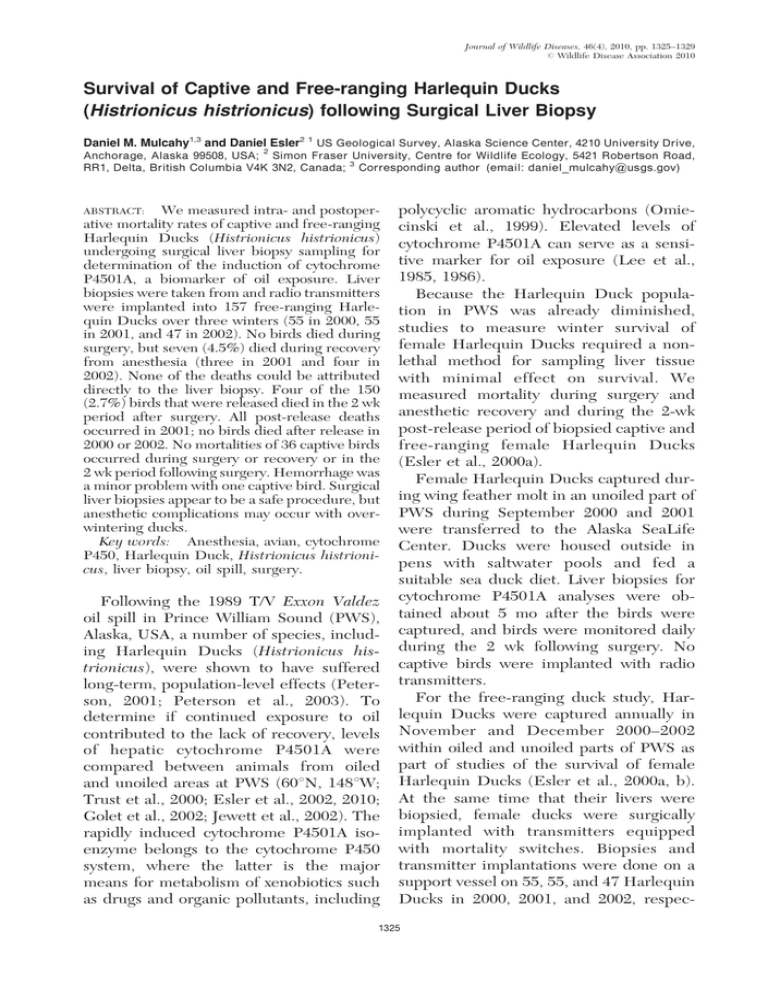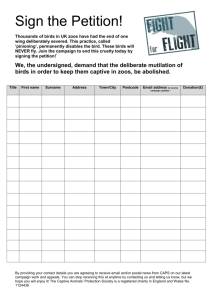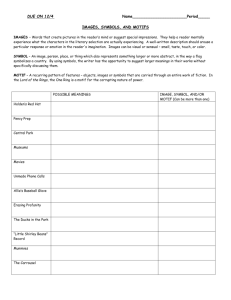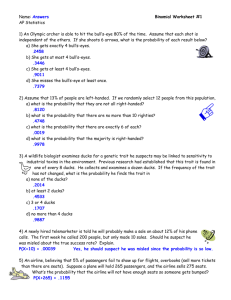Survival of Captive and Free-ranging Harlequin Ducks
advertisement

Journal of Wildlife Diseases, 46(4), 2010, pp. 1325–1329 # Wildlife Disease Association 2010 Survival of Captive and Free-ranging Harlequin Ducks (Histrionicus histrionicus) following Surgical Liver Biopsy Daniel M. Mulcahy1,3 and Daniel Esler2 1 US Geological Survey, Alaska Science Center, 4210 University Drive, Anchorage, Alaska 99508, USA; 2 Simon Fraser University, Centre for Wildlife Ecology, 5421 Robertson Road, RR1, Delta, British Columbia V4K 3N2, Canada; 3 Corresponding author (email: daniel_mulcahy@usgs.gov) ABSTRACT: We measured intra- and postoperative mortality rates of captive and free-ranging Harlequin Ducks (Histrionicus histrionicus) undergoing surgical liver biopsy sampling for determination of the induction of cytochrome P4501A, a biomarker of oil exposure. Liver biopsies were taken from and radio transmitters were implanted into 157 free-ranging Harlequin Ducks over three winters (55 in 2000, 55 in 2001, and 47 in 2002). No birds died during surgery, but seven (4.5%) died during recovery from anesthesia (three in 2001 and four in 2002). None of the deaths could be attributed directly to the liver biopsy. Four of the 150 (2.7%) birds that were released died in the 2 wk period after surgery. All post-release deaths occurred in 2001; no birds died after release in 2000 or 2002. No mortalities of 36 captive birds occurred during surgery or recovery or in the 2 wk period following surgery. Hemorrhage was a minor problem with one captive bird. Surgical liver biopsies appear to be a safe procedure, but anesthetic complications may occur with overwintering ducks. Key words: Anesthesia, avian, cytochrome P450, Harlequin Duck, Histrionicus histrionicus, liver biopsy, oil spill, surgery. Following the 1989 T/V Exxon Valdez oil spill in Prince William Sound (PWS), Alaska, USA, a number of species, including Harlequin Ducks (Histrionicus histrionicus), were shown to have suffered long-term, population-level effects (Peterson, 2001; Peterson et al., 2003). To determine if continued exposure to oil contributed to the lack of recovery, levels of hepatic cytochrome P4501A were compared between animals from oiled and unoiled areas at PWS (60uN, 148uW; Trust et al., 2000; Esler et al., 2002, 2010; Golet et al., 2002; Jewett et al., 2002). The rapidly induced cytochrome P4501A isoenzyme belongs to the cytochrome P450 system, where the latter is the major means for metabolism of xenobiotics such as drugs and organic pollutants, including polycyclic aromatic hydrocarbons (Omiecinski et al., 1999). Elevated levels of cytochrome P4501A can serve as a sensitive marker for oil exposure (Lee et al., 1985, 1986). Because the Harlequin Duck population in PWS was already diminished, studies to measure winter survival of female Harlequin Ducks required a nonlethal method for sampling liver tissue with minimal effect on survival. We measured mortality during surgery and anesthetic recovery and during the 2-wk post-release period of biopsied captive and free-ranging female Harlequin Ducks (Esler et al., 2000a). Female Harlequin Ducks captured during wing feather molt in an unoiled part of PWS during September 2000 and 2001 were transferred to the Alaska SeaLife Center. Ducks were housed outside in pens with saltwater pools and fed a suitable sea duck diet. Liver biopsies for cytochrome P4501A analyses were obtained about 5 mo after the birds were captured, and birds were monitored daily during the 2 wk following surgery. No captive birds were implanted with radio transmitters. For the free-ranging duck study, Harlequin Ducks were captured annually in November and December 2000–2002 within oiled and unoiled parts of PWS as part of studies of the survival of female Harlequin Ducks (Esler et al., 2000a, b). At the same time that their livers were biopsied, female ducks were surgically implanted with transmitters equipped with mortality switches. Biopsies and transmitter implantations were done on a support vessel on 55, 55, and 47 Harlequin Ducks in 2000, 2001, and 2002, respec- 1325 1326 JOURNAL OF WILDLIFE DISEASES, VOL. 46, NO. 4, OCTOBER 2010 tively. Radio-tracking flights began within a week of release and were completed weekly as weather permitted for the following year. Survival rates were reported for the first 2 wk, the period in which surgical complications are most likely to manifest, and the period shown to be ideal for censoring data following transmitter implantation (Esler et al., 2000a). Anesthetic and surgical procedures used on both captive and free–ranging ducks followed methods published for Pigeon Guillemots (Cepphus columba) biopsied in the field (Degernes et al., 2002). Briefly, birds were mask-induced with isoflurane (AerraneH, Anaquest, Madison, Wisconsin, USA) in oxygen (1 l/ min). The birds were intubated with cuffless endotracheal tubes. Body temperature was monitored with an esophageal sensor (Electro-Therm TM99A, Cooper Instrument, Middlefield, Connecticut, USA), and the heart rate was monitored using an esophageal stethoscope (Audible Patient MonitorH, A. M. Bickford, Wales Center, New York, USA). The coelomic incision and antenna exit sites were prepared by applying a water-soluble gel (FacilitatorH, Blue Ridge Pharmaceuticals, Greensboro, North Carolina, USA) to the down feathers. The surgery sites were taped off and disinfected with povidoneiodine and draped. A midline incision was made in the skin and body wall, and the radio (A1–2, Holohil, Carp, Ontario, Canada) was placed into the right abdominal air sac, with the percutaneous antenna exiting ventrolaterally to the tail (Korschgen et al., 1996). Transmitters weighed 18 g (3% of average body weight). Curved forceps were used to isolate an approximately 3310 mm arc of tissue along the edge of the liver. The biopsy was excised, transferred to a cryogenic vial, and placed in liquid nitrogen. The liver edge was crushed for about 30 sec, the forceps were removed, and the liver was inspected for hemorrhage. If bleeding occurred, a small piece of absorbable gelatin foam (GelfoamH, Pharmacia & Upjohn Co., Kala- mazoo, Michigan, USA) was placed on the cut edge. Closure was done in two layers using a simple continuous pattern with 3– 0 polyglactin 910 suture (VicrylH, Ethicon, Somerville, New Jersey, USA). Birds were left intubated on oxygen until they struggled against the endotracheal tube. Birds were held until they could hold their heads erect, and then placed into a kennel for at least 1 hr before release. Gross necropsies were done on all birds that died prior to release. Thirty-six liver biopsy surgeries were done on captive ducks in February 2001 (n517) and 2002 (n519). No captive ducks died during surgery or recovery or in the 2-wk monitoring period following biopsy. Two captive birds (one in 2001 and one in 2002) became severely apneic immediately after extubation. Both apneic birds were re-intubated and survived following oxygen support. Proportions of free-ranging ducks that died were compared using Fisher’s Exact test to a similar group of female Harlequin Ducks radio-marked without liver biopsies (Mulcahy et al., 1999). Mortalities that occurred during anesthetic recovery and mortalities that occurred within 2 wk of release were compared using one-tailed tests of the hypothesis that biopsied birds had higher mortality rates than birds not biopsied. The birds without liver biopsies were captured during wing molt, a period with higher natural survival than winter (Iverson and Esler, 2007). Thus this analysis would overestimate mortality associated with liver biopsy. Liver biopsies were taken from 157 free-ranging ducks in the winters of 2000– 02. No birds died during surgery, but seven (4.5%) died during recovery from anesthesia. In 2000, none of the 55 freeranging birds died during surgery or recovery or in the 2-wk period immediate post-release. In 2001 no birds died during surgery, three of 55 (5%) birds died during recovery, and four of 52 (7%) birds released died in the 2 wk following release. In 2002 no birds died during SHORT COMMUNICATIONS surgery, four of 47 (8%) birds died during recovery, and no birds died in the initial 2 wk after release. All four of the birds that died during the 2-wk post-release period and four of the seven birds that died during recovery had been captured in unoiled areas of PWS. Mean mortality rates during surgery and recovery for the biopsied birds in this study (4.561.6%) were not significantly different (P50.16) from the mortality rate (2.360.9%) for ducks that were implanted but not biopsied (Mulcahy and Esler, 1999). During the 2-wk postoperative period, mortality rates for birds that had liver biopsies (2.761.3%) did not significantly differ (P50.75) from the rate (3.461.1%) reported for ducks implanted but not biopsied (Mulcahy and Esler, 1999). Five of seven free–ranging birds that died during recovery in 2001 and 2002 had survived anesthesia and surgery before developing identical signs and dying. Once the isoflurane was discontinued and the birds were repositioned to ventral or ventrolateral recumbency, they became severely dyspneic, including increased respiratory effort, open-mouthed breathing, and raspy respiratory sounds. Returning the birds to dorsal recumbency did not relieve the dyspnea. Dyspneic birds were given oxygen by facemask or by endotracheal tube for up to 45 min for birds that survived (three in 2001 and one in 2002) or until death occurred. Two additional birds died during recovery in 2001 and 2002 without signs of dyspnea or other gross abnormality. No obvious causes of death were found on necropsy of birds that died during recovery. There were no signs of hemorrhage at the biopsy sites, and no accumulation of blood was found in the coelom. None of the post-release birds that died were recovered. Gelatin foam was applied to the cut edge of the livers that showed any bleeding. In 2000 gelatin foam was applied to the livers of 17 of 55 free–ranging ducks. With experience, gelatin foam was 1327 applied more sparingly and was used in only one free–ranging duck each year in 2001 and 2002. Gelatin foam was used only once in captive ducks. The mean weight of the birds sampled in PWS was 579641 g (range: 372–688 g); the mean weight of the captive birds at surgery was 543635 g (range: 438–601 g). The mean weight of all biopsy samples was 62.4635.6 mg (range: 10.6–181.4 mg). The mean weight of the biopsy samples was 0.01% of the mean weight of the ducks. The largest sample represented 0.05% of the body weight of the smallest duck. The liver samples we took were very small (maximum 181 mg) compared to the size of the lightest duck (372 g) we sampled. Even sizable (6% of liver mass) hepatectomies did not alter serum chemistries or liver function tests in Galahs (Eolophus roseicapillus), and liver mass as a percentage of body weight was restored within 7 days of surgery (Jaensch et al., 2000). Although not measured, liver function of the Harlequin Ducks was not likely affected by the liver biopsies we performed. Hemorrhage was not a significant problem during surgery, and no hemorrhages were found in ducks that died and were necropsied. The severe dyspnea seen in some of the birds that died were not seen in the 307 Harlequin Ducks previously implanted with radio transmitters in PWS (Mulcahy and Esler, 1999; Esler et al., 2000b; Rizzolo et al., 2005; Iverson and Esler, 2006, 2007). However, that work was done during peak wing molt of female ducks from mid-August to mid-September. The present project was done on overwintering female ducks captured in November– December. No severe postsurgical dyspnea and mortality occurred during surgical liver biopsies taken from Pigeon Guillemots during nesting in the spring (Degernes et al., 2002). Similar signs of severe dyspnea leading to death have been seen in Surf Scoters (Melanitta perspicillata), White-winged Scoters (M. fusca), and Steller’s Eiders (Polysticta stelleri) 1328 JOURNAL OF WILDLIFE DISEASES, VOL. 46, NO. 4, OCTOBER 2010 when captured in the winter and implanted with transmitters (Mulcahy, unpubl. data). The stress experienced by wild birds under winter conditions makes some of them poor candidates for capture, anesthesia, and surgery (Stoskopf et al., 2010). The overwinter mortality of Common Guillemots (Uria aalge) was effectively doubled by the additive effects of oil spills and environmental conditions (Votier et al., 2005). Perhaps reflecting the controlled captive environment, none of the captive Harlequin Ducks died following biopsy. Mortality rates of free-ranging Harlequin Ducks during and following liver biopsy were not different from those reported for Harlequin Ducks without liver biopsies (Mulcahy and Esler, 1999). Although all surgical procedures result in a risk of mortality, we found that taking a liver biopsy did not markedly increase this risk over that incurred during radio implant surgeries. Therefore, we consider this an appropriate and relatively safe method of nonlethally obtaining tissue samples for contaminant analysis or other purposes. We thank the crew of the M/V Discovery for field logistics. James Leach and Mark Mitchell provided additional surgical services. Kim Trust and Bruce Woodin supplied the weights of the liver biopsies. Studies were approved by the Institutional Animal Care and Use Committees at the Alaska SeaLife Center and Simon Fraser University. This study was supported by the Exxon Valdez Oil Spill Trustee Council; the authors’ conclusions are their own and do not necessarily reflect the views of the Trustee Council. Mention of trade names does not constitute government endorsement of products. LITERATURE CITED DEGERNES, L. A., C. A. HARMS, G. H. GOLET, AND D. M. MULCAHY. 2002. Anesthesia and liver biopsy techniques for Pigeon Guillemots (Cepphus columba) suspected of exposure to crude oil in marine environments. Journal of Avian Medicine and Surgery 16: 291–299. ESLER, D., T. D. BOWMAN, K. A. TRUST, B. E. BALLACHEY, T. A. DEAN, S. C. JEWETT, AND C. E. O’CLAIR. 2002. Harlequin Duck population recovery following the ‘Exxon Valdez’ oil spill: Progress, process and constraints. Marine Ecology Progress Series 241: 271–286. ———, D. M. MULCAHY, AND R. L. JARVIS. 2000a. Testing assumptions for unbiased estimation of survival of radiomarked harlequin ducks. Journal of Wildlife Management 64: 591–598. ———, J. A. SCHMUTZ, R. L. JARVIS, AND D. M. MULCAHY. 2000b. Winter survival of adult female harlequin ducks in relation to history of contamination by the Exxon Valdez oil spill. Journal of Wildlife Management 64: 839–847. ———, K. A. TRUST, B. E. BALLACHEY, S. A. IVERSON, T. L. LEWIS, D. J. RIZZOLO, D. M. MULCAHY, A. K. MILES, B. R. WOODIN, J. J. STEGEMAN, J. D. HENDERSON, AND B. W. WILSON. 2010. Cytochrome P4501A biomarker indication of oil exposure in harlequin ducks up to 20 years after the Exxon Valdez oil spill. Environmental Toxicology and Chemistry 29: 1138–1145. GOLET, G. H., P. E. SEISER, A. D. MCGUIRE, D. D. ROBY, J. B. FISCHER, K. J. KULETZ, D. B. IRONS, T. A. DEAN, S. C. JEWETT, AND S. H. NEWMAN. 2002. Long-term direct and indirect effects of the ‘Exxon Valdez’ oil spill on Pigeon Guillemots in Prince William Sound, Alaska. Marine Ecology Progress Series 241: 287–304. IVERSON, S. A., AND D. ESLER. 2006. Site fidelity and the demographic implications of winter movements by a migratory bird, the Harlequin Duck Histrionicus histrionicus. Journal of Avian Biology 37: 219–228. ———, AND ———. 2007. Survival of female Harlequin Ducks during wing molt. Journal of Wildlife Management 71: 1220–1224. JAENSCH, S. M., L. CULLEN, AND S. R. RAIDAL. 2000. Assessment of liver function in Galahs (Elophus roseicapillus) after partial hepatectomy: A comparison of plasma enzyme concentrations, serum bile acid levels, and galactose clearance tests. Journal of Avian Medicine and Surgery 14: 164– 171. JEWETT, S. C., T. A. DEAN, B. R. WOODIN, M. K. HOBERG, AND J. J. STEGEMAN. 2002. Exposure to hydrocarbons 10 years after the Exxon Valdez oil spill: Evidence from cytochrome P4501A expression and biliary FACs in nearshore demersal fishes. Marine Environmental Research 54: 21–48. KORSCHGEN, C. E., K. P. KENOW, A. GENDRONFITZPATRICK, W. L. GREEN, AND F. J. DEIN. 1996. Implanting intra-abdominal radiotransmitters with external whip antennas in ducks. Journal of Wildlife Management 60: 132–137. LEE, Y. Z., F. A. LEIGHTON, D. B. PEAKALL, R. J. SHORT COMMUNICATIONS NORSTROM, P. J. O’BRIEN, J. F. PAYNE, AND A. D. RAHIMTULA. 1985. Effects of ingestion of Hibernia and Prudhoe Bay crude oils on hepatic and renal mixed function oxidase in nestling Herring Gulls (Larus argentatus). Environmental Research 36: 248–255. ———, P. J. O’BRIEN, J. F. PAYNE, AND A. D. RAHIMTULA. 1986. Toxicity of petroleum crude oils and their effect on xenobiotic metabolizing enzyme activities in the chicken embryo in ovo. Environmental Research 39: 153–163. MULCAHY, D. M., AND D. ESLER. 1999. Surgical and immediate postrelease mortality of Harlequin Ducks (Histrionicus histrionicus) implanted with abdominal radio transmitters with percutaneous antennae. Journal of Zoo and Wildlife Medicine 30: 397–401. ———, ———, AND M. K. STOSKOPF. 1999. Loss from Harlequin Ducks of abdominally implanted radio transmitters equipped with percutaneous antennas. Journal of Field Ornithology 70: 244–250. OMIECINSKI, C. J., R. P. REMMEL, AND V. P. HOSAGRAHARA. 1999. Concise review of the cytochrome P450s and their roles in toxicology. Toxicological Sciences 48: 151–156. PETERSON, C. H. 2001. The ‘‘Exxon Valdez’’ oil spill in Alaska: Acute, indirect and chronic effects on the ecosystem. Advances in Marine Biology 39: 1–103. 1329 ———, S. D. RICE, J. W. SHORT, D. ESLER, J. L. BODKIN, B. E. BALLACHEY, AND D. B. IRONS. 2003. Long-term ecosystem response to the Exxon Valdez oil spill. Science 302: 2082–2086. RIZZOLO, D. J., D. ESLER, D. D. ROBY, AND R. L. JARVIS. 2005. Do wintering Harlequin Ducks forage nocturnally at high latitudes? Condor 107: 173–177. STOSKOPF, M. K., D. M. MULCAHY, AND D. ESLER. 2010. Evaluation of a portable automated serum chemistry analyzer for field assessment of Harlequin Ducks, Histrionicus histrionicus. Veterinary Medicine International 2010: Article 418596. TRUST, K. A., D. ESLER, B. R. WOODIN, AND J. J. STEGEMAN. 2000. Cytochrome P450 1A induction in sea ducks inhabiting nearshore areas of Prince William Sound, Alaska. Marine Pollution Bulletin 40: 397–403. VOTIER, S. C., B. J. HATCHWELL, A. BECKERMAN, R. H. MCCLEERY, F. M. HUNTER, J. PELLATT, M. TRINDER, AND T. R. BIRKHEAD. 2005. Oil pollution and climate have wide-scale impacts on seabird demographics. Ecology Letters 8: 1157–1164. Submitted for publication 5 April 2010. Accepted 24 June 2010.






